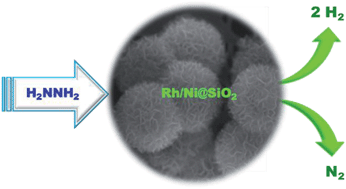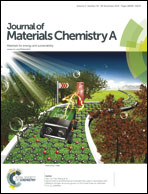Hollow nickel-coated silica microspheres containing rhodium nanoparticles for highly selective production of hydrogen from hydrous hydrazine†
Abstract
The synthesis of hollow nickel-coated silica microspheres containing rhodium nanoparticles (NPs) (Rh/Ni@SiO2) via thermal hydrolysis of urea using core–shell silica microspheres as templates is described. This dissolution-and-deposition method using urea as a precipitating agent provided uniform hollow microspheres composed of amorphous Ni(OH)2 and silica (SiO2) layers along with small amounts of Rh species even without etching; these hollow microspheres transformed to crystalline Rh/Ni@SiO2 microspheres after annealing at 750 °C under a reducing atmosphere. The formation of a hollow structure is dependent on the concentration of urea and unique dissolution behavior of the core–shell silica. The bimetallic Rh/Ni@SiO2 microsphere with a low Rh content (6.35 wt%) is a highly active catalyst for complete dissociation of hydrous hydrazine into hydrogen and nitrogen. Complete release of hydrogen from hydrous hydrazine was accomplished at 25 °C with a H2 selectivity of 99.4% and turnover number of 66. The used Rh/Ni@SiO2 catalyst, which was recovered by a magnet, was reused in subsequent reactions with virtually identical activity.


 Please wait while we load your content...
Please wait while we load your content...